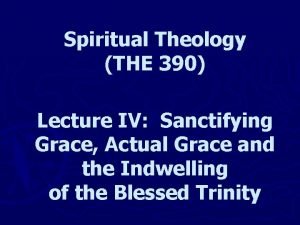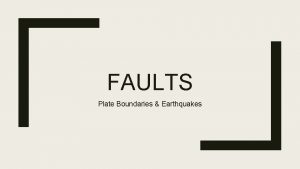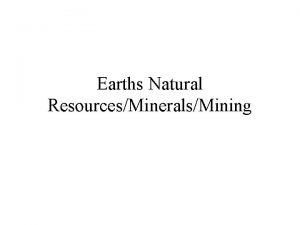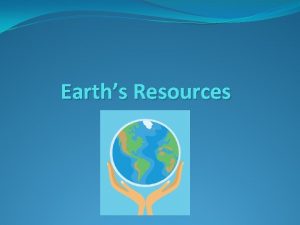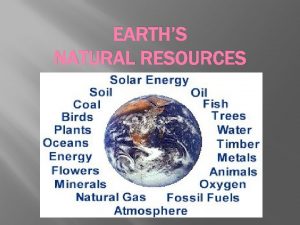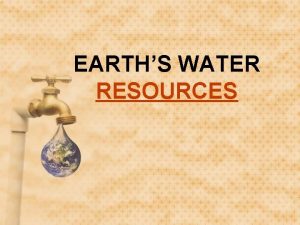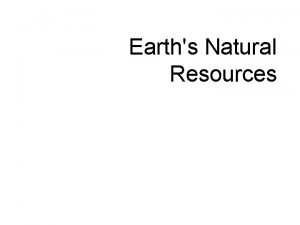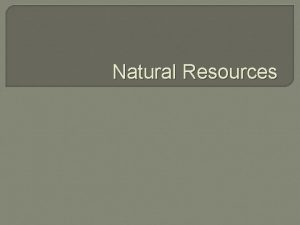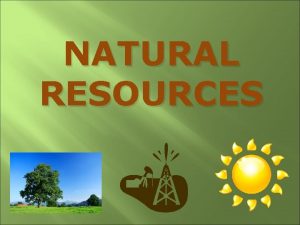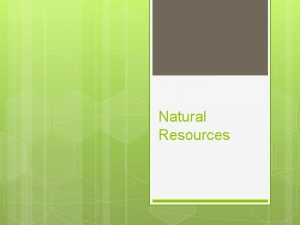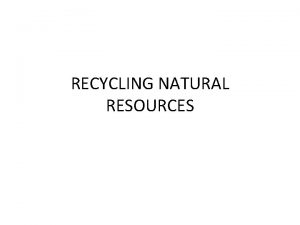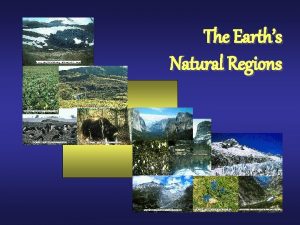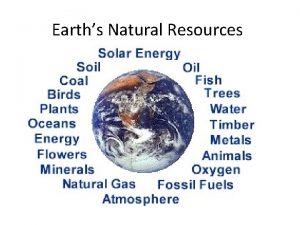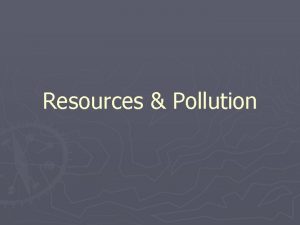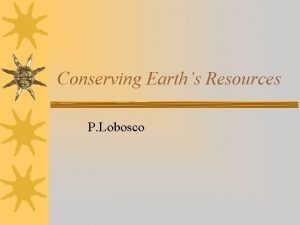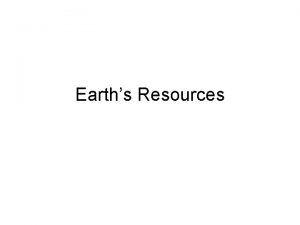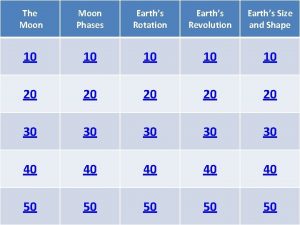EARTHS NATURAL RESOURCES Natural Resources actual or potential


















- Slides: 18

EARTH’S NATURAL RESOURCES

Natural Resources - actual or potential form of wealth supplied by nature. Examples: q Metals � Arable land � Fossil fuels � Old-growth forests � Coal � Oil � Water � Sun � Air � Crops

Renewable Resources - energy sources that can be recycled or replaced by natural processes in less than 100 years Advantages: � Stays for a long time � They are constant Disadvantages: � Expensive � Can harm wildlife � Not reliable � Some put off Examples: �Sun �Wind �Water (groundwater) �Geothermal energy �Forests (trees) �

Nonrenewable Resources - resources that cannot be replaced by natural processes in more than 100 years Advantages: � We need it to make gasoline Examples: � Fossil fuels � Natural gas � Nuclear energy Disadvantages: � Will eventually run out � Acid rain � Air pollution � Water pollution

Fossil Fuels - an energy resource formed from the decayed remains of ancient plants and other organisms Advantages: � A chemical energy is changed into heat and light � Easy to find � Produce large amounts of energy Examples: � Coal � Oil Disadvantages: � Pollutes the atmosphere � Possibly causing climate change � NONRENEWABLE

Coal formed from the remains of ancient swamp vegetation that turned into a soft, brown/black material Advantages: � Changes a chemical to heat and light � Creates energy/electricity � Easy to burn Disadvantages: � Pollutes the atmosphere � Mining it can scar landscape Examples: � Lignite � Bituminous � Anthracite

Oil and Natural Gases - formed over millions of years from the decay of algae and other microscopic ocean organisms called plankton Advantages: � Changes into heat and light � Power vehicles � Power stoves, ovens, fireplaces Disadvantages: � Develops over long periods of time � Air/Water pollution Examples: � Lamp oil � Gasoline � Diesel fuel � Crude oil

Solar Energy - energy from the sun Advantages: � Does not cause hazardous/toxic pollution � RENEWABLE Examples: � Solar panels � Flat mirrors Disadvantages: � We do not have the technology to harness all of its energy � Expensive to cover large areas with solar panels � Noise pollution

Wind Energy - energy produced by wind Advantages: � Nonpolluting (air, land) � Not harmful to the environment � Does not produce waste � RENEWABLE Examples: � Windmills � wind farms Disadvantages: � Few regions have winds strong enough to generate electricity on a large scale � Noise pollution

Hydroelectric Power - production of electricity using water Advantages: � Does not cause pollution and it is � RENEWABLE Examples: � Niagara Falls � Water falls � Dams Disadvantages: � Reservoirs behind the dam can fill up with sediment � Increased erosion

Geothermal Energy - heat from the magma and hot rock that surrounds it that can be used to generate electricity Advantages: � Does not cause pollution � Does not use fuel � Efficient � RENEWABLE Examples: � Geysers � Hot springs Disadvantages: � Sometimes not found, close to Earth’s surface � Can release hot, salty water at Earth’s surface

Nuclear Energy - energy produced by splitting the nuclei of certain elements in a process known as fission (releasing the energy by changing water to steam) Advantages: � Powerful and efficient � Reduces fossil fuels used (lessens cost and lessens greenhouse gas emissions) Examples: q Power plants fueled by uranium Disadvantages: � Storing nuclear waste makes its use limited � Radioactive wastes take a long time to break down � Nuclear accidents

Groundwater - water that soaks into the ground and collects in small spaces between bits of soil and rock Advantages: q Part of water cycle q Free to harvest q RENEWABLE Example: � Used in industries and on farms Disadvantages: � It takes a long time for it to move through rock layers � Much to be done to keep water safe � Huge effort to harvest

Forests - a thick growth of trees and underbrush covering an extensive tract of land Advantages: Disadvantages: � Takes in carbon and stores it � No forests = more � Purifies the air carbon in the atmosphere � Ingredients for medicines � Might cause � Balances the climate global warming) � Regulates the water cycle � RENEWABLE Examples: � Yellowstone � Yosemite � Amazon

Mineral Resources - metal objects that come from rocks Advantages: � Sometimes large deposits of valuable minerals are found in one place � Can be mined for profit � RENEWABLE Disadvantages: � Costs a lot to get the minerals out of the rocks Example: � hematite makes motorcycle parts and saw blades � Diamonds � Gold � Salt � Copper � Iron, etc.

Abiotic Factors - any nonliving part of the environment Examples: � Air current � Temperature � Moisture (water) � Light � Soil

Biotic Factors - any living or once living organism in the environment Examples: � Animals � Plants � Insects � Humans

The End!!!
 Actual yield
Actual yield Actual sin and actual grace
Actual sin and actual grace The actual and potential rival offerings
The actual and potential rival offerings What forces are defining the new marketing realities
What forces are defining the new marketing realities Actual power
Actual power Basalt
Basalt Earths boundaries
Earths boundaries Earths crust
Earths crust Earths major crustal plates
Earths major crustal plates The earth's layers foldable
The earth's layers foldable What's the shape of earth's orbit
What's the shape of earth's orbit Whats earths moon called
Whats earths moon called Earth honey
Earth honey Whats earths moon called
Whats earths moon called Where
Where Earths orbit seasons
Earths orbit seasons Earths kayers
Earths kayers Home sweet biome crossword
Home sweet biome crossword 4 spheres of the earth
4 spheres of the earth

